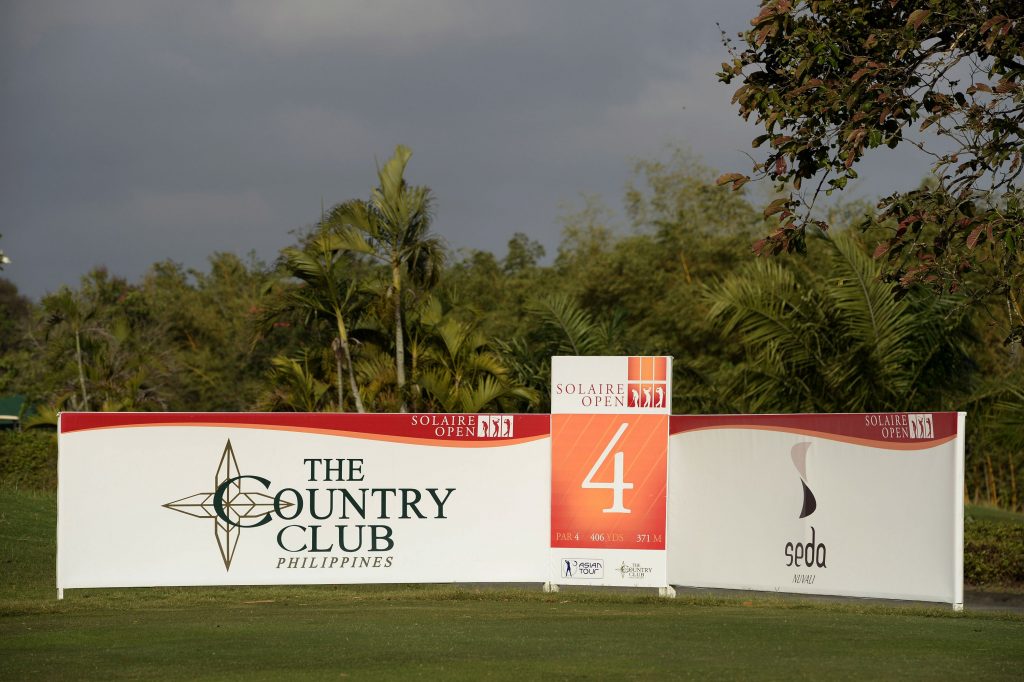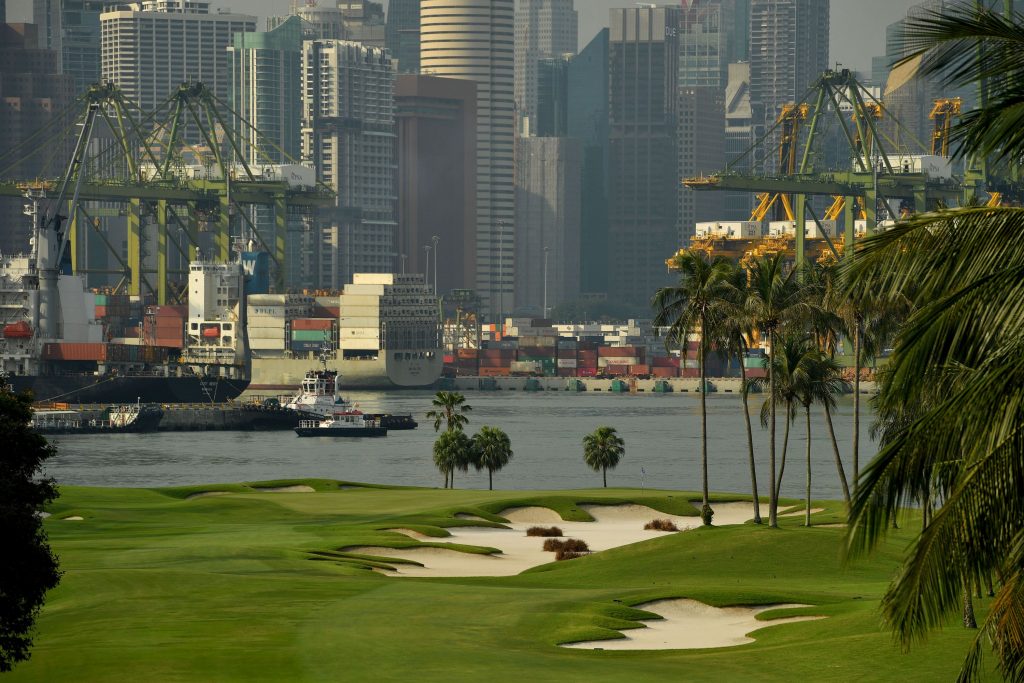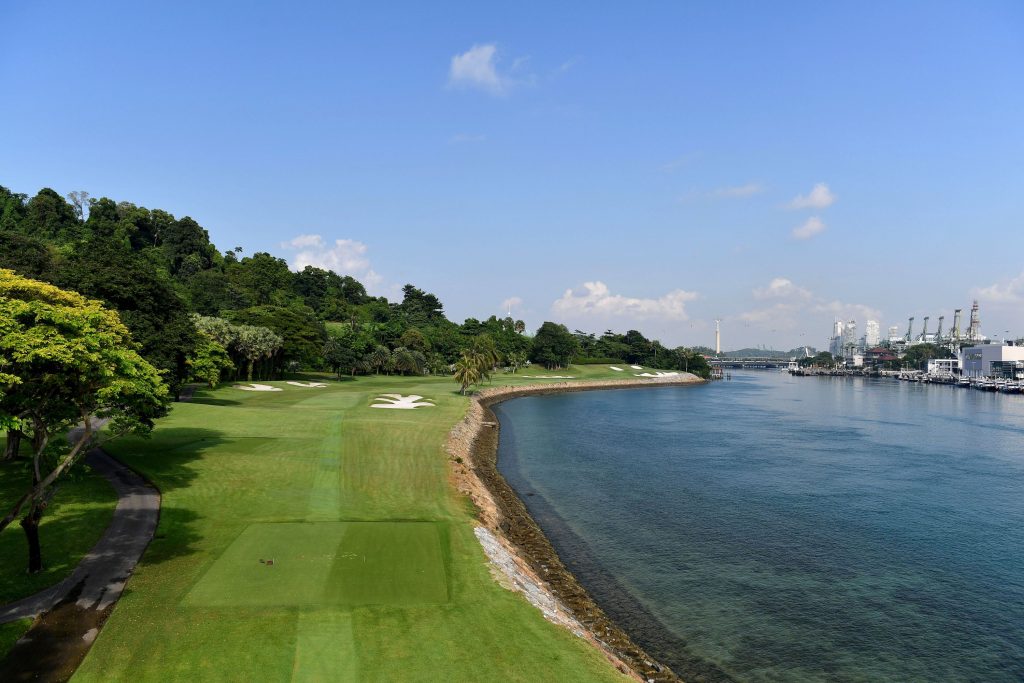Feature: The Asian Tour Monster (Front 9)

Imagine a golf course consisting of the most iconic and challenging holes on the Asian Tour.
A fictional hybrid-layout that features one of the region’s standout opening holes, one of the finest second holes and goes all the way through to an epic 18th.
A layout that would be the ultimate challenge – where breaking par is a monumental achievement.
Well, just such a virtual course now exists, as an Asian Tour panel of experts has selected the appropriate holes to make up what is the golf course of all golf courses in Asia.
With a par of 70 and length of 7,430 yards, we have appropriately named it The Asian Tour Monster.
To navigate us through The Asian Tour Monster, we asked players and experts to describe each hole – all of which have played key roles in many of the biggest tournaments on the Asian Tour.
Let us know what your think on our social media channels – Facebook, Instagram, Twitter.

KOH SAMUI, THAILAND – JUNE 17: Adlison Da Silva of Brazil in action at Santiburi Samui Country Club on June 17, 2012 in Koh Samui, Thailand. (Photo by Paul Lakatos/Asian Tour/Asian Tour via Getty Images)
Hole 1 – Santiburi Samui Country Club, Koh Samui, Thailand
Par: Four
Yardage: 339 yards
Hole scoring average: 4.34
Asian Tour event hosted: Queen’s Cup
Where better to start this iconic course than the holiday island of Koh Samui in Thailand.
But, as with all the holes on The Asian Tour Monster, it is not a hole where you can take a vacation.
Contrary to the name of the hole – which is ‘The Flat Land’ – it is a steep uphill and treacherous opening par four, also widely known as the “Beast of Samui”.
Although it only requires a long-iron or a hybrid off the tee, the precarious elevated fairway is fringed with penalty areas and rocky outcrops. Provided you manage to find the fairway, a mid-iron will then be required for your approach shot. The severe two-tier green which is also elevated will require all your attention as it will most likely yield three putts or more if you are on the wrong level with your approach shot.
The hole is normally played as the 10th by the club members.
“A tall tree is planted just right of the buggy path about 180 yards off the tee which overhangs the fairway. I have seen balls hit that tree and bounce right into the jungle; drop straight down onto the buggy path and basically roll back down to the tee (because of the massive upslope); or hit the tree and disappear altogether.
The second shot – if the fairway is successfully found – will be anywhere from 160 to 180 yards to a green 15 yards higher than the fairway. The green is two tiered – with the tier itself close to four feet.
Hit the ball on the top tier when the pin is on the lower level and players will putt the ball off the green, without a doubt. Hit the ball on the lower tier when the pin is set on the top level … well then players will feel a flex in the putter shaft because of the unusually big swing they have to make.
The placement of this hole, as the opening hole, is perfect to ruin a good round of golf.”
Anthony Kang: a three-time Asian Tour winner and now part of the Asian Tour’s television commentary team.



Hole 2 – Saujana Golf & Country Club (Palm Course), Malaysia
Par: Four
Yardage: 493 yards
Hole scoring average: 4.27
Asian Tour events hosted: Maybank Championship, Malaysian Open
The second hole of the Palm Course at Saujana Golf & Country Club is a true test. Its length alone is enough to make you gasp at what awaits. A very narrow fairway flanked by several bunkers, palm trees and dense jungle on the right waits to punish any wayward drive. The second shot requires a mid to long iron to a green where the surface is not visible due to the steep elevation change. Multiple bunkers encompass the large two-tiered green – so making sure your approach shot is on the correct level is imperative.
“The second hole at Saujana is a bit of a difficult one because it is quite long. Much depends on which way the wind is blowing, if it is a little into the wind I will aim down the left with a driver with a little fade – to get past the fairway bunker on the right. But if there is no wind, and conditions are favourable, I will hit a three wood down there.
For the second it can anything from a six to a nine iron into the green – depending on where the pin and wind is. Normally I just try and get my shot to the middle tier if the pin is at the back or if the pin is at the front I always try to get it to the front edge – because if you don’t get up on the green it rolls back down. Definitely stay away from the right hand front bunker because it is just dead in there, because it is so deep. It is just one of those holes where you have to respect making a four and get out of there and you are happy with it.”
Scott Hend: a 10-time winner on the Asian Tour, the 2016 Asian Tour Order of Merit champion and winner of the 2019 Maybank Championship – played on the Palm Course at Saujana.



Hole 3 – Kurmitola Golf Club, Bangladesh
Par: Four
Yardage: 448 yards
Hole scoring average: 4.5
Asian Tour event hosted: Bangabandhu Cup Golf Open
With its tree-lined fairways and intimidating water features, the third hole at Kurmitola Golf Club can challenge every aspect of your game. Off the tee you need a well-struck drive to the corner of a narrow fairway, which doglegs to the left. Bunkers await on either side to swallow any stray drive and any attempt at cutting the corner can result in disaster – as an OB looms nearby. There is also the possibility of losing your ball due to the dense treeline. Even if you manage to negotiate the tee shot, you are still left with a long-iron to a shallow undulating green which yields very few birdies.
“I grew up on this course and we always play it as a par five. For me this hole is a standard par five and as one of the shorter hitters on Tour I can handle it. But when the Asian Tour are here in Bangladesh we play it as a par four and it is a really hard hole for all of us!
But now days I am hitting it a little bit longer and I can make birdies more often here. I had a chat with myself and said I have played many par fours on Tour that are more difficult than this hole, so I am now mentally stronger playing the hole.
Before, I would play driver, then lay up 100 yards to the pin because I am very strong anywhere from 100 yards. Nowadays, I play driver and then a 22-degree hybrid.”
Siddikur Rahman: a two-time winner on the Asian Tour, two-time champion on the Asian Development Tour, and the first golfer from Bangladesh to win on the Asian Tour – at the Brunei Open in 2010.



MANILA-PHILIPPINES-The Solaire Open at The Country Club, Manila, Philippines, March 13-16, 2014. a US$ 300.000 Asian Tour event. Picture by Paul Lakatos/Asian Tour.
Hole 4 – The Country Club, Philippines
Par: Four
Yardage: 406 yards
Hole scoring average: 4.52
Asian Tour event hosted: Solaire Open
On this slight dogleg right par-four, a driver is usually required as the further you hit, the wider the landing area is going to be. The purpose-built gap in the fairway to intentionally stop players from laying up is just merciless! Your thought process is tested even more with the OB to the left and water all the way down the right. Once you have recovered from the stress of the tee shot, a small elevated green awaits – which, if you miss the green with your approach, is very difficult to get up and down from.
The Country Club hosted the Solaire Open in 2014 which saw Canada’s Richard T. Lee triumph. Lee double bogeyed the fourth hole on the final day, but recovered brilliantly to claim his first Asian Tour title. That week there were two quintuple bogeys and five quadruple bogeys on the fourth.
“It is a narrow hole with a wind blowing normally, making it a real test. As the wind always blows right to left you have to start the ball at the ravine on the right otherwise you are in danger of going OB left. The fairway is only about 25 metres wide and with the wind and distance it plays quite long, so you need a driver and a mid to long iron to get to the putting surface.”
Koh Dengshan: a former Singapore national player, now Asian Tour regular and touring professional with Sentosa Golf Club.



SINGAPORE – Serapong course at Sentosa Golf Club, Singapore, September 10-15, 2017. Picture by Paul Lakatos/Sentosa Golf Club.
Hole 5 – The Serapong, Sentosa Golf Club, Singapore
Par: Four
Yardage: 486 yards
Hole scoring average: 4.23
Asian Tour event hosted: SMBC Singapore Open
The signature hole on the Serapong Course at Sentosa Golf Club boasts wonderful views of the Singapore skyline that look out onto one of the busiest ports in the world. However, do not allow these views to distract you. This demanding par four, especially when played into the wind, requires your best drive of the day to give yourself the shortest possible approach shot into this shallow and firm green. For shorter hitters this may still require a wood.
The landing area off the tee is fairly generous with large bunkers on either side of the fairway. However, club selection for your approach shot needs to be spot on. A yawning waste bunker stretches its way up the right side of the fairway ready to swallow any mishit shot, and any over-clubbed shot will likely end up in the sea!
“I really dreaded playing this hole during tournament play, simply due to its sheer length. Pars, let alone birdies, were hard to come by, especially when the pin was tucked on the right portion of the green where the water starts to come into play.
When this hole plays its full length, I would need to hit a solid drive and then try to figure out how to keep the ball on the firm green with a long iron in hand.
I think my greatest joy playing this hole came when, on one occasion, my drive hit a sprinkler head and gave me an extra 40 yards, making my approach shot that much shorter, but I still made a bogey!
Make a par on this hole and you will definitely gain at least half a shot on the field!”
Unho Park: an Asian Tour player for 20 years, now a Tour administrator.



Hole 6, par-3.
December 22, 2010. Thai Country Club, Bangkok, Thailand. Mandatory credit: Richard Castka/Sportpix International
Hole 6 – Thai Country Club, Bangkok, Thailand
Par: Three
Yardage: 227 yards
Hole scoring average: 3.17
Asian Tour events hosted: Thailand Open, Volvo Masters of Asia, Asian Honda Classic
The par-three sixth hole is the signature hole at Thai Country Club. It is a long par three over water with strong head winds more often than not. The smart play is to aim for the left side of the green in order to avoid the penalty area and bunker on the right. However, if you stray too far left, the undulations will most certainly throw your ball further away from the green, leaving a tricky up and down to make par. This is just a brute of a par-three where its sheer length just makes playing this hole strenuous.
American John Catlin – who recently won the Andalucia Masters at Valderrama on the European Tour – parred the hole in his first three rounds during the 2019 Thailand Open and made birdie on Sunday, which paved the way for him to secure his fourth Asian Tour title.
“It is a long par three. Off the back it is about 220 – 230 yards to the middle of the green. The wind mostly blows in from the right, so I would have a three iron or five wood. There is a bunker and water on the right side so anything from the middle of the green to the left side is the perfect shot. I will take a three any day there. It is not a birdie hole. You have to be conservative. I had four pars during the Thailand Open in 2018 when I won there, I didn’t lose any strokes there but didn’t make any either.”
Panuphol Pittayarat: winner of the 2018 Thailand Open at Thai Country Club – which is his home club.



SINGAPORE – Serapong course at Sentosa Golf Club, Singapore, September 10-15, 2017. Picture by Paul Lakatos/Sentosa Golf Club.
Hole 7 – The Serapong, Sentosa Golf Club, Singapore
Par: Five
Yardage: 587 yards
Hole scoring average: 5.01
Asian Tour event hosted: SMBC Singapore Open
You may think a par-five that averages near its par in tournament play is a simple enough hole but on the seventh hole on The Serapong, the devil is in the details. You are greeted on the tee with a magnificent turquoise ocean canal stretching the full length of the hole on the right.
With little to no rough on the right-hand side of the fairway, shots that veer right will almost certainly find the drink. The left side of the hole also intimidates you with dense tropical jungle. If you are skilled enough to thread your tee shot between the fairway bunkers, you are left with a very tricky lay-up that needs to be precisely planned and executed to the narrowest part of the fairway.
Any miscue can be calamitous as this year’s SMBC Singapore Open champion, Matt Kuchar, found out by carding an eight in the final round. After a poor tee shot, which went left into the trees, an unexpected air shot ensued while trying to extricate his ball from tree roots. A pulled approach shot, which ended up out of bounds, also did not help his cause. Remarkably, he did not drop a shot after, played the back nine in four under, and beat Justin Rose by three!
“It is a very good hole. It depends how you drive that hole. If you hit a bomb off the tee, 320 yards, you can reach the green in two. But then you still have to hit a quality shot to get on the green. I don’t hit the ball so long these days so I lay up with a three wood, then a four iron and a pitching wedge or nine. The hole is also one of the most scenic on the course.”
Mardan Mamat: a five-time Asian Tour champion and Singapore’s pioneering professional golfer.



MANILA, PHILIPPINES – The ICTSI Philippine Open at the Wack Wack Golf and Country Club on February 9-12, 2012 in Manila, Philippines. Photo by Paul Lakatos/Asian Tour.
Hole 8 – Wack Wack Golf Club, Philippines
Par: Three
Yardage: 191 yards
Hole scoring average: 3.55
Asian Tour event hosted: Philippine Open
The original design of this eighth hole was a lot shorter, requiring only an eight or nine iron to a postage-stamp type green, which was raised even higher than it is today. With its increased length and slightly lowered green, it is still as formidable as ever and can mentally rattle anyone’s nerves when standing on the tee box.
The view of a severely elevated narrow green sloping from back to front and guarded by multiple deep bunkers gives birth to unimaginable scenarios if you fail to hit this green. Although it may sound simple to blast out of the bunkers or chip onto the green after missing it, the nature of the green makes it almost impossible to get the ball on the green when trying to recover from the left or right.
“When I won the Philippine Open in 2008, that hole was played as the 17th hole. And it is funny because having played Wack Wack so many times, amongst friends we have always talked about what you would do if you go into that hole with a one-shot lead. And funny enough, it happened to me – I had a one shot lead in the Philippine Open in 2008. If you have played it long enough, and as much as you want to hit the green, you know you must miss it to the right.
Back then it was only an eight or nine iron but after I won they lengthened it from the back tees, it’s like a six iron now. So what I did was I made sure I aimed a bit more right and tried to hit a good shot, fortunately it landed on the green and just rolled off and ended up in the right bunker. The guy I was up against, Gavin Flint, also did the same thing, and we ended up making bogies but a par was good enough for me to win on the last.”
Angelo Que: a three-time champion on the Asian Tour and a winner on the Japan Golf Tour Organization.



Delhi Golf Club, Hole #9
Hole 9 – Delhi Golf Club, India
Par: Four
Yardage: 445 yards
Hole scoring average: 4.38
Asian Tour events hosted: Hero Indian Open, Panasonic Open India
The ninth hole at the Delhi Golf Club requires precision and makes even the most confident drivers of the ball tremble, especially when a tournament is on the line. This hole has a reputation for being extremely unforgiving with a narrow fairway and thorn bushes on either side. The hole does not have any significant water hazards but the bunkers, unforgiving rough and mature tree line more than make up for that.
You can choose to use either a three wood or long iron off the tee in order to find the widest part of the fairway, or in this case, the least narrow! But the challenge with this strategy means it leaves a mid to long iron approach shot to an undulating, multi-tiered L-shaped green guarded by well positioned bunkers and thorn bushes. The braver folk will opt to use a driver, however any miscue will most certainly result in playing three from the tee.
“As a member over there, it is probably regarded as the hardest hole on the course even though it is not stroke index one – simply because it gives you a few options. It is long enough to tempt you to hit a driver off the tee but it really narrows in at about the 270 to 280 yard mark – the fairway becomes half its width. It is a perfect risk reward hole if you are willing to man up and take it on with a driver, which really makes your second shot a lot shorter into a green that is quite demanding because it is a raised green that falls off to the right. The typical Sunday pin there was back right over a bunker and if you laid back too far, if you hit a three wood or a two iron off the tee, it would leave you too long a shot to be able to access that flag in anyway.
I have seen a lot of big numbers there; I have seen a lot of people lose tournaments there in the past; and I personally have made some high numbers on that hole. When we play tournaments there, the prevailing wind is normally into the wind and coming off to the left so that makes it even more demanding. It is about 440 yards, but it plays closer to 460 or 470. You also have bushes down the sides, so visually it is a very intimidating hole. I think some of the hardest holes in golf are the ones that are straight and not actually dog-legs. About five years ago there used to be a tree in the middle of the fairway, on the left half of it – it fell down in a storm. When that tree was there it made it even more challenging because if you hit anything up the left half you didn’t have a clear shot – so it was even more demanding before.”
Shiv Kapur: a four-time Asian Tour winner, and former Asian Games Gold medallist.


Feature: The Asian Tour Monster (Front 9)
By - Serene Loh
[addtoany]


Imagine a golf course consisting of the most iconic and challenging holes on the Asian Tour. A fictional hybrid-layout that features one of the region’s standout opening holes, one of the finest second holes and goes all the way through to an epic 18th.
Imagine a golf course consisting of the most iconic and challenging holes on the Asian Tour.
A fictional hybrid-layout that features one of the region’s standout opening holes, one of the finest second holes and goes all the way through to an epic 18th.
A layout that would be the ultimate challenge – where breaking par is a monumental achievement.
Well, just such a virtual course now exists, as an Asian Tour panel of experts has selected the appropriate holes to make up what is the golf course of all golf courses in Asia.
With a par of 70 and length of 7,430 yards, we have appropriately named it The Asian Tour Monster.
To navigate us through The Asian Tour Monster, we asked players and experts to describe each hole – all of which have played key roles in many of the biggest tournaments on the Asian Tour.
Let us know what your think on our social media channels – Facebook, Instagram, Twitter.



KOH SAMUI, THAILAND – JUNE 17: Adlison Da Silva of Brazil in action at Santiburi Samui Country Club on June 17, 2012 in Koh Samui, Thailand. (Photo by Paul Lakatos/Asian Tour/Asian Tour via Getty Images)
Hole 1 – Santiburi Samui Country Club, Koh Samui, Thailand
Par: Four
Yardage: 339 yards
Hole scoring average: 4.34
Asian Tour event hosted: Queen’s Cup
Where better to start this iconic course than the holiday island of Koh Samui in Thailand.
But, as with all the holes on The Asian Tour Monster, it is not a hole where you can take a vacation.
Contrary to the name of the hole – which is ‘The Flat Land’ – it is a steep uphill and treacherous opening par four, also widely known as the “Beast of Samui”.
Although it only requires a long-iron or a hybrid off the tee, the precarious elevated fairway is fringed with penalty areas and rocky outcrops. Provided you manage to find the fairway, a mid-iron will then be required for your approach shot. The severe two-tier green which is also elevated will require all your attention as it will most likely yield three putts or more if you are on the wrong level with your approach shot.
The hole is normally played as the 10th by the club members.
“A tall tree is planted just right of the buggy path about 180 yards off the tee which overhangs the fairway. I have seen balls hit that tree and bounce right into the jungle; drop straight down onto the buggy path and basically roll back down to the tee (because of the massive upslope); or hit the tree and disappear altogether.
The second shot – if the fairway is successfully found – will be anywhere from 160 to 180 yards to a green 15 yards higher than the fairway. The green is two tiered – with the tier itself close to four feet.
Hit the ball on the top tier when the pin is on the lower level and players will putt the ball off the green, without a doubt. Hit the ball on the lower tier when the pin is set on the top level … well then players will feel a flex in the putter shaft because of the unusually big swing they have to make.
The placement of this hole, as the opening hole, is perfect to ruin a good round of golf.”
Anthony Kang: a three-time Asian Tour winner and now part of the Asian Tour’s television commentary team.



Hole 2 – Saujana Golf & Country Club (Palm Course), Malaysia
Par: Four
Yardage: 493 yards
Hole scoring average: 4.27
Asian Tour events hosted: Maybank Championship, Malaysian Open
The second hole of the Palm Course at Saujana Golf & Country Club is a true test. Its length alone is enough to make you gasp at what awaits. A very narrow fairway flanked by several bunkers, palm trees and dense jungle on the right waits to punish any wayward drive. The second shot requires a mid to long iron to a green where the surface is not visible due to the steep elevation change. Multiple bunkers encompass the large two-tiered green – so making sure your approach shot is on the correct level is imperative.
“The second hole at Saujana is a bit of a difficult one because it is quite long. Much depends on which way the wind is blowing, if it is a little into the wind I will aim down the left with a driver with a little fade – to get past the fairway bunker on the right. But if there is no wind, and conditions are favourable, I will hit a three wood down there.
For the second it can anything from a six to a nine iron into the green – depending on where the pin and wind is. Normally I just try and get my shot to the middle tier if the pin is at the back or if the pin is at the front I always try to get it to the front edge – because if you don’t get up on the green it rolls back down. Definitely stay away from the right hand front bunker because it is just dead in there, because it is so deep. It is just one of those holes where you have to respect making a four and get out of there and you are happy with it.”
Scott Hend: a 10-time winner on the Asian Tour, the 2016 Asian Tour Order of Merit champion and winner of the 2019 Maybank Championship – played on the Palm Course at Saujana.



Hole 3 – Kurmitola Golf Club, Bangladesh
Par: Four
Yardage: 448 yards
Hole scoring average: 4.5
Asian Tour event hosted: Bangabandhu Cup Golf Open
With its tree-lined fairways and intimidating water features, the third hole at Kurmitola Golf Club can challenge every aspect of your game. Off the tee you need a well-struck drive to the corner of a narrow fairway, which doglegs to the left. Bunkers await on either side to swallow any stray drive and any attempt at cutting the corner can result in disaster – as an OB looms nearby. There is also the possibility of losing your ball due to the dense treeline. Even if you manage to negotiate the tee shot, you are still left with a long-iron to a shallow undulating green which yields very few birdies.
“I grew up on this course and we always play it as a par five. For me this hole is a standard par five and as one of the shorter hitters on Tour I can handle it. But when the Asian Tour are here in Bangladesh we play it as a par four and it is a really hard hole for all of us!
But now days I am hitting it a little bit longer and I can make birdies more often here. I had a chat with myself and said I have played many par fours on Tour that are more difficult than this hole, so I am now mentally stronger playing the hole.
Before, I would play driver, then lay up 100 yards to the pin because I am very strong anywhere from 100 yards. Nowadays, I play driver and then a 22-degree hybrid.”
Siddikur Rahman: a two-time winner on the Asian Tour, two-time champion on the Asian Development Tour, and the first golfer from Bangladesh to win on the Asian Tour – at the Brunei Open in 2010.



MANILA-PHILIPPINES-The Solaire Open at The Country Club, Manila, Philippines, March 13-16, 2014. a US$ 300.000 Asian Tour event. Picture by Paul Lakatos/Asian Tour.
Hole 4 – The Country Club, Philippines
Par: Four
Yardage: 406 yards
Hole scoring average: 4.52
Asian Tour event hosted: Solaire Open
On this slight dogleg right par-four, a driver is usually required as the further you hit, the wider the landing area is going to be. The purpose-built gap in the fairway to intentionally stop players from laying up is just merciless! Your thought process is tested even more with the OB to the left and water all the way down the right. Once you have recovered from the stress of the tee shot, a small elevated green awaits – which, if you miss the green with your approach, is very difficult to get up and down from.
The Country Club hosted the Solaire Open in 2014 which saw Canada’s Richard T. Lee triumph. Lee double bogeyed the fourth hole on the final day, but recovered brilliantly to claim his first Asian Tour title. That week there were two quintuple bogeys and five quadruple bogeys on the fourth.
“It is a narrow hole with a wind blowing normally, making it a real test. As the wind always blows right to left you have to start the ball at the ravine on the right otherwise you are in danger of going OB left. The fairway is only about 25 metres wide and with the wind and distance it plays quite long, so you need a driver and a mid to long iron to get to the putting surface.”
Koh Dengshan: a former Singapore national player, now Asian Tour regular and touring professional with Sentosa Golf Club.



SINGAPORE – Serapong course at Sentosa Golf Club, Singapore, September 10-15, 2017. Picture by Paul Lakatos/Sentosa Golf Club.
Hole 5 – The Serapong, Sentosa Golf Club, Singapore
Par: Four
Yardage: 486 yards
Hole scoring average: 4.23
Asian Tour event hosted: SMBC Singapore Open
The signature hole on the Serapong Course at Sentosa Golf Club boasts wonderful views of the Singapore skyline that look out onto one of the busiest ports in the world. However, do not allow these views to distract you. This demanding par four, especially when played into the wind, requires your best drive of the day to give yourself the shortest possible approach shot into this shallow and firm green. For shorter hitters this may still require a wood.
The landing area off the tee is fairly generous with large bunkers on either side of the fairway. However, club selection for your approach shot needs to be spot on. A yawning waste bunker stretches its way up the right side of the fairway ready to swallow any mishit shot, and any over-clubbed shot will likely end up in the sea!
“I really dreaded playing this hole during tournament play, simply due to its sheer length. Pars, let alone birdies, were hard to come by, especially when the pin was tucked on the right portion of the green where the water starts to come into play.
When this hole plays its full length, I would need to hit a solid drive and then try to figure out how to keep the ball on the firm green with a long iron in hand.
I think my greatest joy playing this hole came when, on one occasion, my drive hit a sprinkler head and gave me an extra 40 yards, making my approach shot that much shorter, but I still made a bogey!
Make a par on this hole and you will definitely gain at least half a shot on the field!”
Unho Park: an Asian Tour player for 20 years, now a Tour administrator.



Hole 6, par-3.
December 22, 2010. Thai Country Club, Bangkok, Thailand. Mandatory credit: Richard Castka/Sportpix International
Hole 6 – Thai Country Club, Bangkok, Thailand
Par: Three
Yardage: 227 yards
Hole scoring average: 3.17
Asian Tour events hosted: Thailand Open, Volvo Masters of Asia, Asian Honda Classic
The par-three sixth hole is the signature hole at Thai Country Club. It is a long par three over water with strong head winds more often than not. The smart play is to aim for the left side of the green in order to avoid the penalty area and bunker on the right. However, if you stray too far left, the undulations will most certainly throw your ball further away from the green, leaving a tricky up and down to make par. This is just a brute of a par-three where its sheer length just makes playing this hole strenuous.
American John Catlin – who recently won the Andalucia Masters at Valderrama on the European Tour – parred the hole in his first three rounds during the 2019 Thailand Open and made birdie on Sunday, which paved the way for him to secure his fourth Asian Tour title.
“It is a long par three. Off the back it is about 220 – 230 yards to the middle of the green. The wind mostly blows in from the right, so I would have a three iron or five wood. There is a bunker and water on the right side so anything from the middle of the green to the left side is the perfect shot. I will take a three any day there. It is not a birdie hole. You have to be conservative. I had four pars during the Thailand Open in 2018 when I won there, I didn’t lose any strokes there but didn’t make any either.”
Panuphol Pittayarat: winner of the 2018 Thailand Open at Thai Country Club – which is his home club.



SINGAPORE – Serapong course at Sentosa Golf Club, Singapore, September 10-15, 2017. Picture by Paul Lakatos/Sentosa Golf Club.
Hole 7 – The Serapong, Sentosa Golf Club, Singapore
Par: Five
Yardage: 587 yards
Hole scoring average: 5.01
Asian Tour event hosted: SMBC Singapore Open
You may think a par-five that averages near its par in tournament play is a simple enough hole but on the seventh hole on The Serapong, the devil is in the details. You are greeted on the tee with a magnificent turquoise ocean canal stretching the full length of the hole on the right.
With little to no rough on the right-hand side of the fairway, shots that veer right will almost certainly find the drink. The left side of the hole also intimidates you with dense tropical jungle. If you are skilled enough to thread your tee shot between the fairway bunkers, you are left with a very tricky lay-up that needs to be precisely planned and executed to the narrowest part of the fairway.
Any miscue can be calamitous as this year’s SMBC Singapore Open champion, Matt Kuchar, found out by carding an eight in the final round. After a poor tee shot, which went left into the trees, an unexpected air shot ensued while trying to extricate his ball from tree roots. A pulled approach shot, which ended up out of bounds, also did not help his cause. Remarkably, he did not drop a shot after, played the back nine in four under, and beat Justin Rose by three!
“It is a very good hole. It depends how you drive that hole. If you hit a bomb off the tee, 320 yards, you can reach the green in two. But then you still have to hit a quality shot to get on the green. I don’t hit the ball so long these days so I lay up with a three wood, then a four iron and a pitching wedge or nine. The hole is also one of the most scenic on the course.”
Mardan Mamat: a five-time Asian Tour champion and Singapore’s pioneering professional golfer.



MANILA, PHILIPPINES – The ICTSI Philippine Open at the Wack Wack Golf and Country Club on February 9-12, 2012 in Manila, Philippines. Photo by Paul Lakatos/Asian Tour.
Hole 8 – Wack Wack Golf Club, Philippines
Par: Three
Yardage: 191 yards
Hole scoring average: 3.55
Asian Tour event hosted: Philippine Open
The original design of this eighth hole was a lot shorter, requiring only an eight or nine iron to a postage-stamp type green, which was raised even higher than it is today. With its increased length and slightly lowered green, it is still as formidable as ever and can mentally rattle anyone’s nerves when standing on the tee box.
The view of a severely elevated narrow green sloping from back to front and guarded by multiple deep bunkers gives birth to unimaginable scenarios if you fail to hit this green. Although it may sound simple to blast out of the bunkers or chip onto the green after missing it, the nature of the green makes it almost impossible to get the ball on the green when trying to recover from the left or right.
“When I won the Philippine Open in 2008, that hole was played as the 17th hole. And it is funny because having played Wack Wack so many times, amongst friends we have always talked about what you would do if you go into that hole with a one-shot lead. And funny enough, it happened to me – I had a one shot lead in the Philippine Open in 2008. If you have played it long enough, and as much as you want to hit the green, you know you must miss it to the right.
Back then it was only an eight or nine iron but after I won they lengthened it from the back tees, it’s like a six iron now. So what I did was I made sure I aimed a bit more right and tried to hit a good shot, fortunately it landed on the green and just rolled off and ended up in the right bunker. The guy I was up against, Gavin Flint, also did the same thing, and we ended up making bogies but a par was good enough for me to win on the last.”
Angelo Que: a three-time champion on the Asian Tour and a winner on the Japan Golf Tour Organization.



Delhi Golf Club, Hole #9
Hole 9 – Delhi Golf Club, India
Par: Four
Yardage: 445 yards
Hole scoring average: 4.38
Asian Tour events hosted: Hero Indian Open, Panasonic Open India
The ninth hole at the Delhi Golf Club requires precision and makes even the most confident drivers of the ball tremble, especially when a tournament is on the line. This hole has a reputation for being extremely unforgiving with a narrow fairway and thorn bushes on either side. The hole does not have any significant water hazards but the bunkers, unforgiving rough and mature tree line more than make up for that.
You can choose to use either a three wood or long iron off the tee in order to find the widest part of the fairway, or in this case, the least narrow! But the challenge with this strategy means it leaves a mid to long iron approach shot to an undulating, multi-tiered L-shaped green guarded by well positioned bunkers and thorn bushes. The braver folk will opt to use a driver, however any miscue will most certainly result in playing three from the tee.
“As a member over there, it is probably regarded as the hardest hole on the course even though it is not stroke index one – simply because it gives you a few options. It is long enough to tempt you to hit a driver off the tee but it really narrows in at about the 270 to 280 yard mark – the fairway becomes half its width. It is a perfect risk reward hole if you are willing to man up and take it on with a driver, which really makes your second shot a lot shorter into a green that is quite demanding because it is a raised green that falls off to the right. The typical Sunday pin there was back right over a bunker and if you laid back too far, if you hit a three wood or a two iron off the tee, it would leave you too long a shot to be able to access that flag in anyway.
I have seen a lot of big numbers there; I have seen a lot of people lose tournaments there in the past; and I personally have made some high numbers on that hole. When we play tournaments there, the prevailing wind is normally into the wind and coming off to the left so that makes it even more demanding. It is about 440 yards, but it plays closer to 460 or 470. You also have bushes down the sides, so visually it is a very intimidating hole. I think some of the hardest holes in golf are the ones that are straight and not actually dog-legs. About five years ago there used to be a tree in the middle of the fairway, on the left half of it – it fell down in a storm. When that tree was there it made it even more challenging because if you hit anything up the left half you didn’t have a clear shot – so it was even more demanding before.”
Shiv Kapur: a four-time Asian Tour winner, and former Asian Games Gold medallist.
Headlines at a glance
- King of the Screen Kim shows he is the real deal at GS Caltex Maekyung Open
- GS Caltex Maekyung Open: Route 66 puts ‘Ironman’ Lee in driver’s seat
- GS Caltex Maekyung Open: Chonlatit snatches lead with stunning 62
- GS Caltex Maekyung Open: Flawless veteran Kang still has what it takes
- Koh and Jung committed to finding success overseas on the Asian Tour
- May 2024
- April 2024
- March 2024
- February 2024
- January 2024
- December 2023
- November 2023
- October 2023
- September 2023
- August 2023
- July 2023
- June 2023
- May 2023
- April 2023
- March 2023
- February 2023
- January 2023
- December 2022
- November 2022
- October 2022
- September 2022
- August 2022
- July 2022
- June 2022
- May 2022
- April 2022
- March 2022
- February 2022
- January 2022
- December 2021
- November 2021
- October 2021
- September 2021
- August 2021
- July 2021
- June 2021
- May 2021
- April 2021
- March 2021
- February 2021
- January 2021
- December 2020
- November 2020
- October 2020
- September 2020
- August 2020
- July 2020
- June 2020
- May 2020
- April 2020
- March 2020
- February 2020
- January 2020
- December 2019
- November 2019
- October 2019
- September 2019
- August 2019
- July 2019
- June 2019
- May 2019
- April 2019
- March 2019
- February 2019
- January 2019
- December 2018
- November 2018
- October 2018
- September 2018
- August 2018
- July 2018
- June 2018
- May 2018
- April 2018
- March 2018
- February 2018
- January 2018
- December 2017
- November 2017
- October 2017
- September 2017
- May 2017
- March 2015
- April 2013
- March 2013
- February 2013
- January 2013
- January 2009










Recent Comments